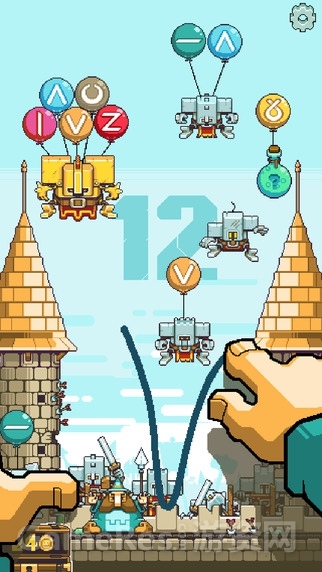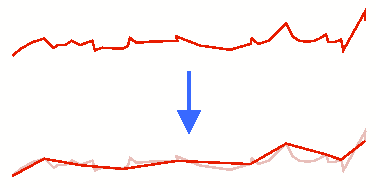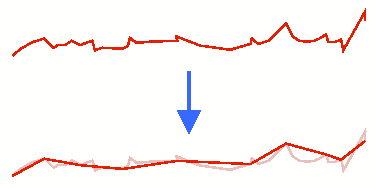|
|
井号键编译
如何写一个简单的手写识别算法,可以精准快速的识别出自定义的简单图形:

把所有的笔画定义了个8个方向,然后将B的笔画可以分解成一个字符串。然后当人在触摸屏上画出一个符号时,也将它分解成8个方向的字符串,最后比较两个字符串的距离就能判断出和不同符号的近似度。

实现起来也很简单,第一步去噪,因为不同触摸屏的采样频率不同。

实现代码:
- void GestureAlgorithm::addPoint(int x, int y){int d_x, d_y;
- d_x = x-positions.back().x;d_y = y-positions.back().y;
- if( d_x*d_x + d_y*d_y >= MIN_MOVEMENT){updateStatistic(x, y);recognizeGesture();}}
- void GestureAlgorithm::updateStatistic(int x, int y){positions.push_back(Point(x, y));point_num = positions.size();if(point_num >1){// For Point Recognizationdist_sum += positions.begin()->dist(x,y);dist_average =dist_sum/(point_num - 1);
- // For Line Recognization// Need a patch for the V0 calculation.Point v0 = Point(positions[1].x - positions[0].x, positions[0].y );Point v1 = Point(x - positions[0].x, y -positions[0].y);if(normalize(v0) && normalize( v1)){float theta = acos(dot(v0, v1));theta_sum += theta;theta_sqsum += sq(theta);theta_average = theta_sum / (float)(point_num - 1);theta_factor = sqrt((float)(point_num - 1)*theta_sqsum - sq(theta_sum))/(point_num-1);}}mainDirections = detectDirection(positions);
- //Statistic Updatepos_x_sum += x;pos_y_sum += y;pos_xx_sum += sq(x);pos_xy_sum += x * y;
- midPoint = Point(pos_x_sum/point_num, pos_y_sum/point_num);curGestureRender->render_bbox->addPoint(x, y);}
第二步把去噪后的数据转换成方向序列,把之前得到的点换成方向序列,并把方向序列归纳到之前定义的8个方向中去。

实现代码: - PosList GestureAlgorithm::limitDirections(const PosList &positions)
- {
- PosList res;
- int lastx, lasty;
- bool firstTime = true;
- for( PosList::const_iterator ii = positions.begin(); ii != positions.end(); ++ii )
- {
- if( firstTime )
- {
- lastx = ii->x;
- lasty = ii->y;
- firstTime = false;
- }
- else
- {
- int dx, dy;
- dx = ii->x – lastx;
- dy = ii->y – lasty;
- if( dy > 0 )
- {
- if( dx > dy || -dx > dy )
- dy = 0;
- else
- dx = 0;
- }
- else
- {
- if( dx > -dy || -dx > -dy )
- dy = 0;
- else
- dx = 0;
- }
- res.push_back( Point( dx, dy ) );
- lastx = ii->x;
- lasty = ii->y;
- }
- }
- return res;
- }
-
第三步把连续一致的方向合并。
实现代码: - Position Num: 141
- X= 113 Y= 0
- X= 0 Y= -15
- X= 0 Y= 179
- X= 13 Y= 0
- X= -110 Y= 0
- X= 0 Y= 6
- X= 0 Y= -101
- X= 3 Y= 0
- Directions Number: 8
- Directions Length:540
- UP Number: 3 Down Number: 2 Left: 1 right 2
- Position Num: 142
- PosList GestureAlgorithm::simplify(const PosList &positions)
- {
- PosList res;
- int lastdx = 0, lastdy = 0;
- bool firstTime = true;
- int index=0;
- for( PosList::const_iterator ii = positions.begin(); ii != positions.end(); ++ii )
- {
- if( firstTime )
- {
- lastdx = ii->x;
- lastdy = ii->y;
- firstTime = false;
- }
- else
- {
- bool joined = false;
- if( (lastdx > 0 && ii->x > 0) || (lastdx < 0 && ii->x < 0) )
- {
- lastdx += ii->x;
- joined = true;
- }
- if( (lastdy > 0 && ii->y > 0) || (lastdy < 0 && ii->y < 0) )
- {
- lastdy += ii->y;
- joined = true;
- }
- if( !joined )
- {
- res.push_back( Point( lastdx, lastdy ) );
- lastdx = ii->x;
- lastdy = ii->y;
- }
- }
- }
- if( lastdx != 0 || lastdy != 0 )
- {
- res.push_back( Point( lastdx, lastdy ) );
- }
- return res;
- }
第四步把小片段的移动略去,最后就能得出其实是画了一个凹的形状。
实现代码: - PosList GestureAlgorithm::removeShortestNoise(const PosList &positions)
- {
- PosList res;
- int shortestSoFar;
- PosList::const_iterator shortest;
- bool firstTime = true;
- for( PosList::const_iterator ii = positions.begin(); ii != positions.end(); ++ii )
- {
- if( firstTime )
- {
- shortestSoFar = ii->x*ii->x + ii->y*ii->y;
- shortest = ii;
- firstTime = false;
- }
- else
- {
- if( (ii->x*ii->x + ii->y*ii->y) < shortestSoFar ) { shortestSoFar = ii->x*ii->x + ii->y*ii->y;
- shortest = ii;
- }
- }
- }
- for( PosList::const_iterator ii = positions.begin(); ii != positions.end(); ++ii )
- {
- if( ii != shortest)
- res.push_back( *ii );
- }
- return res;
- }
- PosList GestureAlgorithm::detectDirection(const PosList &positions)
- {
- PosList directions = simplify(limitDirections(positions));
- double minLength = calcLength(directions) *minMatch;
- while(directions.size() > 0 && calcLength(removeShortestNoise(directions)) > minLength)
- {
- directions = simplify(removeShortestNoise(directions));
- }
- upNum = 0; downNum = 0; leftNum = 0; rightNum =0;
- for(int i = 0; i< directions.size(); i++) { if(directions[i].y >= 0 && directions[i].x ==0)
- upNum++;
- else if(directions[i].y < 0 && directions[i].x ==0) downNum++; else if(directions[i].x >= 0 && directions[i].y ==0 )
- leftNum++;
- else if(directions[i].x < 0 && directions[i].y ==0 )
- rightNum++;
- }
- return directions;
- }
这个算法的厉害之处是可以实时识别,画到一半也能判断出来。
|
|